DFCANet: A Novel Lightweight Convolutional Neural Network Model for Corn Disease Identification
Abstract
:1. Introduction
- (1)
- Proposing a lightweight convolutional neural network model, called DFCANet, based on DFCA blocks and DS blocks, which are used to identify corn diseases in real environments.
- (2)
- Exploring an online data augmentation method for images of corn leaf diseases.
- (3)
- Comparing the DFCANet with other classical network models to prove the performance advantages of DFCANet and conduct ablation experiments to verify the validity of the different module designs.
2. Materials and Methods
2.1. Data Acquisition and Preprocessing
2.2. DFCANet Model
2.2.1. DFCANet
2.2.2. DFCA Block
2.2.3. Depthwise and Pointwise Convolution
2.2.4. Inverted Bottleneck
2.2.5. Coordinate Attention Module
2.2.6. DS Block
2.3. Experimental Environment and Hyperparameter Setting
2.4. Evaluation Indexes
3. Results
3.1. Impact of Different Data Augmentation Methods on the Model
3.2. Comparative Experiment of Different Network Models
3.3. Ablation Experiments
3.4. Simulation of Real Weather Data Augmentation Experiments
3.5. Comparative Experiments of the Public Datasets
4. Discussion
5. Future Work
6. Conclusions
Author Contributions
Funding
Institutional Review Board Statement
Data Availability Statement
Conflicts of Interest
References
- Qiqi, W.; Yinjun, C. Advantages Analysis of Corn Planting in China. J. Agric. Sci. Technol. 2018, 20, 1. [Google Scholar]
- Li, X.; Dong, Y.; Huang, H.; You, H. Effects of fungicides on disease control and yield and quality of silage corn. Mod. Anim. Husb. Technol. 2020, 4, 7–9. [Google Scholar]
- Shiferaw, B.; Prasanna, B.M.; Hellin, J.; Bänziger, M. Crops that feed the world 6. Past successes and future challenges to the role played by corn in global food security. Food Secur. 2011, 3, 307–327. [Google Scholar] [CrossRef] [Green Version]
- Aravind, K.R.; Raja, P.; Mukesh, K.V.; Aniirudh, R.; Ashiwin, R.; Szczepanski, C. Disease Classification in Corn Crop Using Bag of Features and Multiclass Support Vector Machine. In Proceedings of the 2018 2nd International Conference on Inventive Systems and Control (ICISC), Coimbatore, India, 19–20 January 2018; pp. 1191–1196. [Google Scholar]
- Kusumo, B.S.; Heryana, A.; Mahendra, O.; Pardede, H.F. Machine Learning-Based for Automatic Detection of Corn-Plant Diseases Using Image Processing. In Proceedings of the International conference on computer, control, informatics and its applications (IC3INA), IEEE, Tangerang, Indonesia, 1–2 November 2018; pp. 93–97. [Google Scholar]
- Ahila Priyadharshini, R.; Arivazhagan, S.; Arun, M.; Mirnalini, A. Maize leaf disease classification using deep convolutional neural networks. Neural Comput. Appl. 2019, 31, 8887–8895. [Google Scholar] [CrossRef]
- Panigrahi, K.P.; Sahoo, A.K.; Das, H. A cnn approach for corn leaves disease detection to support digital agricultural system. In Proceedings of the 2020 4th International Conference on Trends in Electronics and Informatics (ICOEI) (48184), Tirunelveli, India, 15–17 June 2020; pp. 678–683. [Google Scholar]
- Mohanty, S.P.; Hughes, D.P.; Salathé, M. Using deep learning for image-based plant disease detection. Front. Plant Sci. 2016, 7, 1419. [Google Scholar] [CrossRef] [Green Version]
- Mishra, S.; Sachan, R.; Rajpal, D. Deep convolutional neural network based detection system for real-time corn plant disease recognition. Procedia Comput. Sci. 2020, 167, 2003–2010. [Google Scholar] [CrossRef]
- Saleem, M.H.; Potgieter, J.; Arif, K.M. Plant disease detection and classification by deep learning. Plants 2019, 8, 468. [Google Scholar] [CrossRef] [Green Version]
- Ferentinos, K.P. Deep learning models for plant disease detection and diagnosis. Comput. Electron. Agric. 2018, 145, 311–318. [Google Scholar] [CrossRef]
- Lv, M.; Zhou, G.; He, M.; Chen, A.; Zhang, W.; Hu, Y. Corn leaf disease identification based on feature enhancement and DMS-robust alexnet. IEEE Access. 2020, 8, 57952–57966. [Google Scholar] [CrossRef]
- Zeng, W.; Li, H.; Hu, G.; Liang, D. Identification of corn leaf diseases by using the SKPSNet-50 convolutional neural network model. Sustain. Comput. Inform. Syst. 2020, 35, 100695. [Google Scholar]
- Pandey, A.; Jain, K. A robust deep attention dense convolutional neural network for plant leaf disease identification and classification from smart phone captured real world images. Ecol. Inform. 2022, 70, 101725. [Google Scholar] [CrossRef]
- Zhu, W.; Sun, J.; Wang, S.; Shen, J.; Yang, K.; Zhou, X. Identifying Field Crop Diseases Using Transformer-Embedded Convolutional Neural Network. Agriculture 2022, 12, 1083. [Google Scholar] [CrossRef]
- Chen, W.; Chen, J.; Duan, R.; Fang, Y.; Ruan, Q.; Zhang, D. MS-DNet: A mobile neural network for plant disease identification. Comput. Electron. Agric. 2020, 199, 107175. [Google Scholar] [CrossRef]
- Chen, J.; Zhang, D.; Zeb, A.; Nanehkaran, Y.A. Identification of rice plant diseases using lightweight attention networks. Expert Syst. Appl. 2021, 169, 114514. [Google Scholar] [CrossRef]
- Yin, C.; Zeng, T.; Zhang, H.; Fu, W.; Wang, L.; Yao, S. Maize small leave spot classification based on improved deep convolutional neural network with multi-scale attention mechanism. Agronomy 2022, 12, 906. [Google Scholar] [CrossRef]
- Zeng, W.; Li, H.; Hu, G.; Liang, D. Lightweight dense-scale network (LDSNet) for corn leaf disease identification. Comput. Electron. Agri. 2022, 197, 106943. [Google Scholar] [CrossRef]
- Lin, J.; Chen, X.; Pan, R.; Cao, T.; Cai, J.; Chen, Y.; Peng, X.; Cernava, T.; Zhang, X. GrapeNet: A Lightweight Convolutional Neural Network Model for Identification of Grape Leaf Diseases. Agriculture 2022, 12, 887. [Google Scholar] [CrossRef]
- Sun, C.; Shrivastava, A.; Singh, S.; Gupta, A. Revisiting Unreasonable Effectiveness of Data in Deep Learning Era. In Proceedings of the IEEE International Conference on Computer Vision (ICCV), Venice, Italy, 22–29 October 2017; pp. 843–852. [Google Scholar]
- Krizhevsky, A.; Sutskever, I.; Hinton, G.E. Imagenet classification with deep convolutional neural networks. Adv. Neural Inf. Process. Syst. 2012, 60, 84–90. [Google Scholar] [CrossRef] [Green Version]
- Lin, T.Y.; Maire, M.; Belongie, S.; Hays, J.; Perona, P.; Ramanan, D.; Dollár, P.; Zitnick, C.L. Microsoft Coco: Common objects in context. In Proceedings of the European Conference on Computer Vision (ECCV), Zurich, Switzerland, 6–12 September 2014; pp. 740–755. [Google Scholar]
- Pan, S.-Q.; Qiao, J.-F.; Wang, R.; Yu, H.-L.; Wang, C.; Taylor, K.; Pan, H.-Y. Intelligent diagnosis of northern corn leaf blight with deep learning model. J. Integr. Agric. 2022, 21, 1094–1105. [Google Scholar] [CrossRef]
- Richey, B.; Shirvaikar, M.V. Deep learning based real-time detection of northern corn leaf blight crop disease using YoloV4. In Proceedings of the Real-Time Image Processing and Deep Learning 2021, Electric Network, 12–16 April 2021; Volume 11736, pp. 39–45. [Google Scholar]
- Goodfellow, I.; Pouget-Abadie, J.; Mirza, M.; Xu, B.; Warde-Farley, D.; Ozair, S.; Courville, A.; Bengio, Y. Generative adversarial nets. Adv. Neural Inf. Process. Syst. 2014, 27, 139–144. [Google Scholar]
- Chen, J.; Wang, W.; Zhang, D.; Zeb, A.; Nanehkaran, Y.A. Attention embedded lightweight network for corn disease recognition. Plant Pathol. 2021, 70, 630–642. [Google Scholar] [CrossRef]
- Albarrak, K.; Gulzar, Y.; Hamid, Y.; Mehmood, A.; Soomro, A.B. A Deep Learning-Based Model for Date Fruit Classification. Sustainability 2022, 14, 6339. [Google Scholar] [CrossRef]
- Gulzar, Y.; Hamid, Y.; Soomro, A.B.; Alwan, A.A.; Journaux, L. A convolution neural network-based seed classification system. Symmetry 2020, 12, 2018. [Google Scholar] [CrossRef]
- Hamid, Y.; Wani, S.; Soomro, A.B.; Alwan, A.A.; Gulzar, Y. Smart seed classification system based on MobileNetV2 architecture. In Proceedings of the 2022 2nd International Conference on Computing and Information Technology (ICCIT), Tabuk, Saudi Arabia, 25–27 January 2022; pp. 217–222. [Google Scholar]
- Ahmad, A.; Saraswat, D.; Gamal, A.E.; Johal, G. CD&S Dataset: Handheld Imagery Dataset Acquired Under Field Conditions for Corn Disease Identification and Severity Estimation. arXiv 2021, arXiv:2110.12084. [Google Scholar]
- Singh, D.; Jain, N.; Jain, P.; Kayal, P.; Kumawat, S.; Batra, N. PlantDoc: A dataset for visual plant disease detection. In Proceedings of the 7th ACM IKDD CoDS and 25th COMAD, ACM KDD, Hyderabad, India, 5–7 January 2020; pp. 249–253. [Google Scholar]
- Gong, C.; Wang, D.; Li, M.; Chandra, V.; Liu, Q. Keepaugment: A simple information-preserving data augmentation approach. In Proceedings of the IEEE/CVF Conference on Computer Vision and Pattern Recognition (CVPR), Electr Network, 19–25 June 2021; pp. 1055–1064. [Google Scholar]
- DeVries, T.; Taylor, G.W. Improved regularization of convolutional neural networks with cutout. arXiv 2017, arXiv:1708.04552. [Google Scholar]
- Zhong, Z.; Zheng, L.; Kang, G.; Li, S.; Yang, Y. Random erasing data augmentation. Proc. AAAI Conf. Artif. Intell. 2020, 34, 13001–13008. [Google Scholar] [CrossRef]
- Chen, P.; Liu, S.; Zhao, H.; Jia, J. Gridmask data augmentation. arXiv 2020, arXiv:2001.04086. [Google Scholar]
- Hou, Q.; Zhou, D.; Feng, J. Coordinate Attention for Efficient Mobile Network Design. In Proceedings of the IEEE/CVF Conference on Computer Vision and Pattern Recognition (CVPR), Electr Network, 19–25 June 2021; pp. 13713–13722. [Google Scholar]
- Liu, Z.; Mao, H.; Wu, C.Y.; Feichtenhofer, C.; Darrell, T.; Xie, S. A Convnet for the 2020s. In Proceedings of the IEEE/CVF Conference on Computer Vision and Pattern Recognition (CVPR), New Orleans, LA, USA, 21–24 June 2022; pp. 11976–11986. [Google Scholar]
- He, K.; Zhang, X.; Ren, S.; Sun, J. Deep residual learning for image recognition. In Proceedings of the IEEE Conference on Computer Vision and Pattern Recognition (CVPR), Seattle, WA, USA, 27–30 June 2016; pp. 770–778. [Google Scholar]
- Sandler, M.; Howard, A.; Zhu, M.; Zhmoginov, A.; Chen, L.-C. Mobilenetv2: Inverted residuals and linear bottlenecks. In Proceedings of the IEEE Conference on Computer Vision and Pattern Recognition (CVPR), Salt Lake City, UT, USA, 18–23 June 2018; pp. 4510–4520. [Google Scholar]
- Kingma, D.P.; Ba, J. Adam: A method for stochastic optimization. arXiv 2014, arXiv:1412.6980. [Google Scholar]
- Simonyan, K.; Zisserman, A. Very deep convolutional networks for large-scale image recognition. arXiv 2014, arXiv:1409.1556. [Google Scholar]
- Tan, M.; Le, Q. Efficientnet: Rethinking model scaling for convolutional neural networks. In Proceedings of the 36th International Conference on Machine Learning (ICML) PMLR, Long Beach, CA, USA, 9–15 June 2019; pp. 6105–6114. [Google Scholar]
- Huang, G.; Liu, Z.; Van Der Maaten, L.; Weinberger, K.Q. Densely connected convolutional networks. In Proceedings of the IEEE Conference on Computer Vision and Pattern Recognition (CVPR), Honolulu, HI, USA, 21–26 July 2017; pp. 4700–4708. [Google Scholar]
- Howard, A.; Sandler, M.; Chu, G.; Chen, L.C.; Chen, B.; Tan, M.; Wang, W.; Zhu, Y.; Pang, R.; Vasudevan, V.; et al. Searching for Mobilenetv3. In Proceedings of the IEEE/CVF International Conference on Computer Vision (ICCV), Seoul, Republic of Korea, 27 October–2 November 2019; pp. 1314–1324. [Google Scholar]
- Ma, N.; Zhang, X.; Zheng, H.-T.; Sun, J. Shufflenet v2: Practical guidelines for efficient Cnn architecture design. In Proceedings of the European Conference on Computer Vision (ECCV), Munich, Germany, 8–14 September 2018; pp. 116–131. [Google Scholar]
- Hu, J.; Shen, L.; Sun, G. Squeeze-And-Excitation networks. In Proceedings of the IEEE Conference on Computer Vision and Pattern Recognition (CVPR), Salt Lake City, UT, USA, 18–22 June 2018; pp. 7132–7141. [Google Scholar]
- Woo, S.; Park, J.; Lee, J.Y.; Kweon, I.S. Cbam: Convolutional block attention module. In Proceedings of the European Conference on Computer Vision (ECCV), Munich, Germany, 8–14 September 2018; pp. 3–19. [Google Scholar]
- Selvaraju, R.R.; Cogswell, M.; Das, A.; Vedantam, R.; Parikh, D.; Batra, D. Grad-Cam: Visual explanations from deep networks via gradient-based localization. In Proceedings of the IEEE International Conference on Computer Vision (ICCV), Venice, Italy, 22–29 October 2017; pp. 618–626. [Google Scholar]
- Mohameth, F.; Chen, B.C.; Kane, A.S. Plant disease detection with deep learning and feature extraction using plant village. J. Computer. Commun. 2020, 8, 10–22. [Google Scholar] [CrossRef]
- Huang, J.P.; Chen, J.; Li, K.X.; Li, J.Y.; Liu, H. Identification of multiple plant leaf diseases using neural architecture search. Trans. Chin. Soc. Agric. Eng. 2020, 36, 166–173. [Google Scholar]
- Liu, J.; Wang, X. Plant diseases and pests detection based on deep learning: A review. Plant Methods 2021, 17, 22. [Google Scholar] [CrossRef] [PubMed]
- Subetha, T.; Khilar, R.; Christo, M.S. A comparative analysis on plant pathology classification using deep learning architecture–Resnet and VGG19. Mater. Today Proc. 2021, in press. [Google Scholar]
- Zhao, S.; Peng, Y.; Liu, J.; Wu, S. Tomato Leaf Disease Diagnosis Based on Improved Convolution Neural Network by Attention Module. Agriculture 2021, 11, 651. [Google Scholar] [CrossRef]
- Lin, J.; Chen, Y.; Pan, R.; Cao, T.; Cai, J.; Yu, D.; Chi, X.; Cernava, T.; Zhang, X.; Chen, X. CAMFFNet: A novel convolutional neural network model for tobacco disease image recognition. Comput. Electron. Agric. 2022, 202, 107390. [Google Scholar] [CrossRef]
- Gao, R.; Wang, R.; Feng, L.; Li, Q.; Wu, H. Dual-branch, efficient, channel attention-based crop disease identification. Comput. Electron. Agric. 2021, 190, 106410. [Google Scholar] [CrossRef]
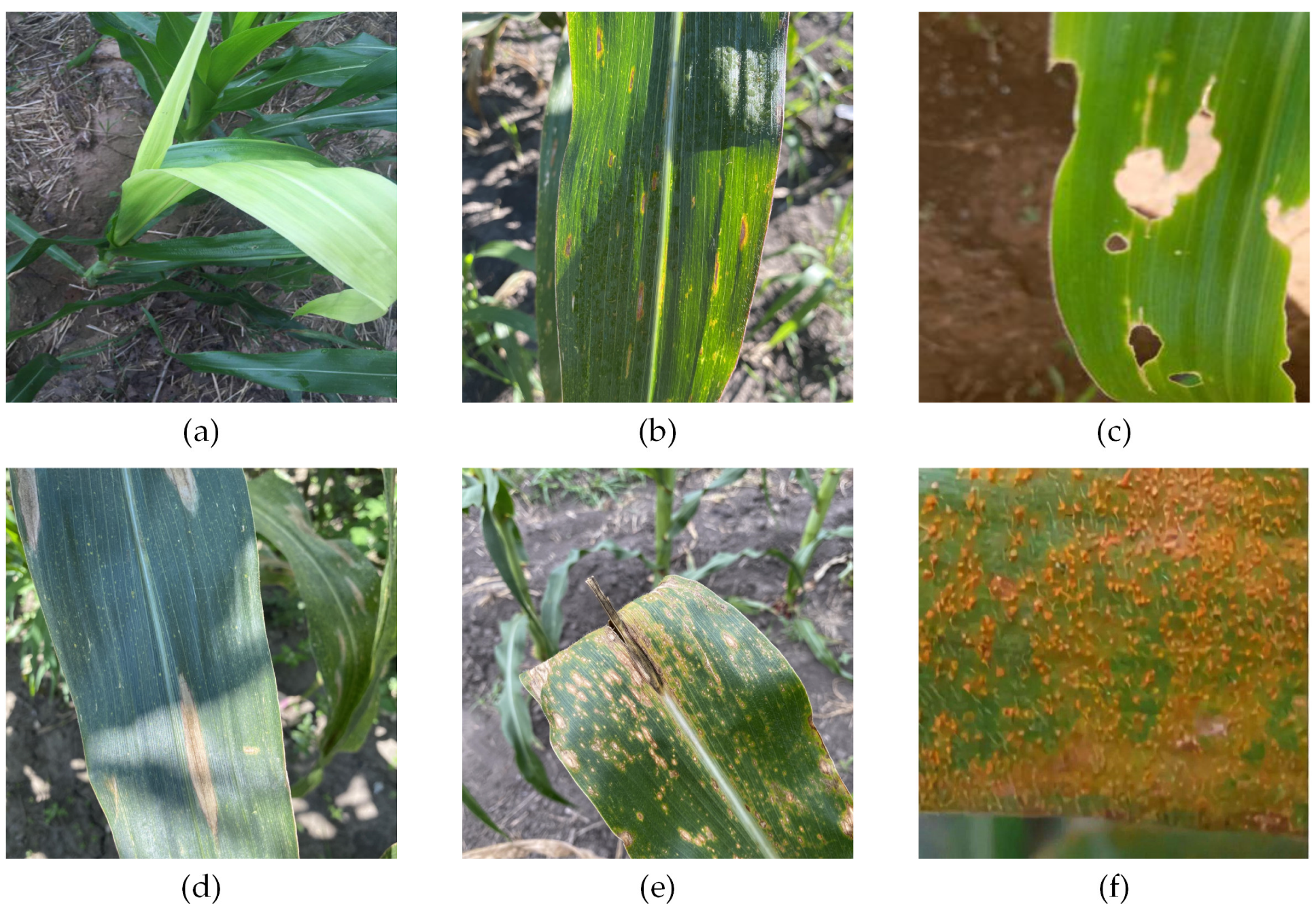
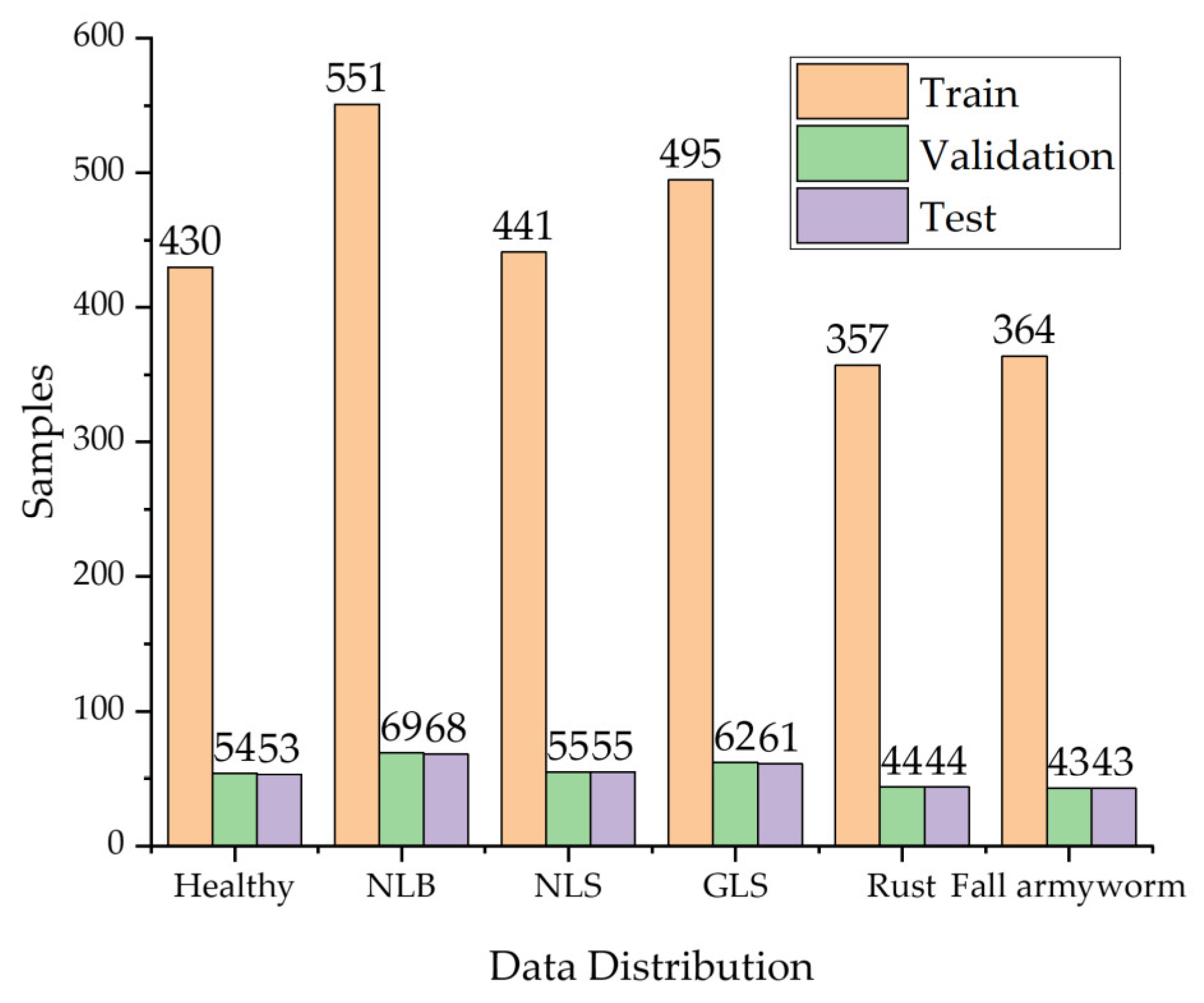


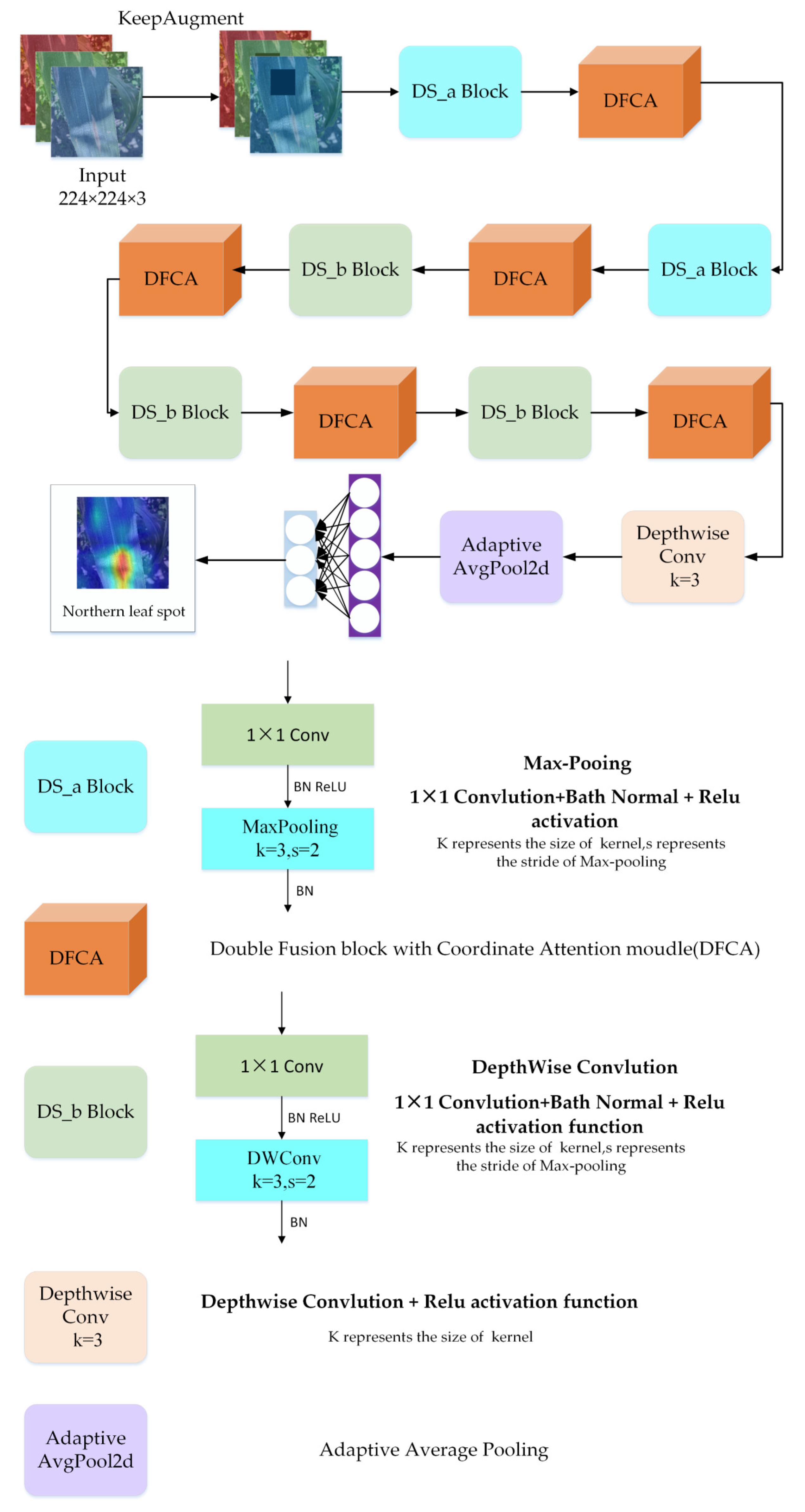

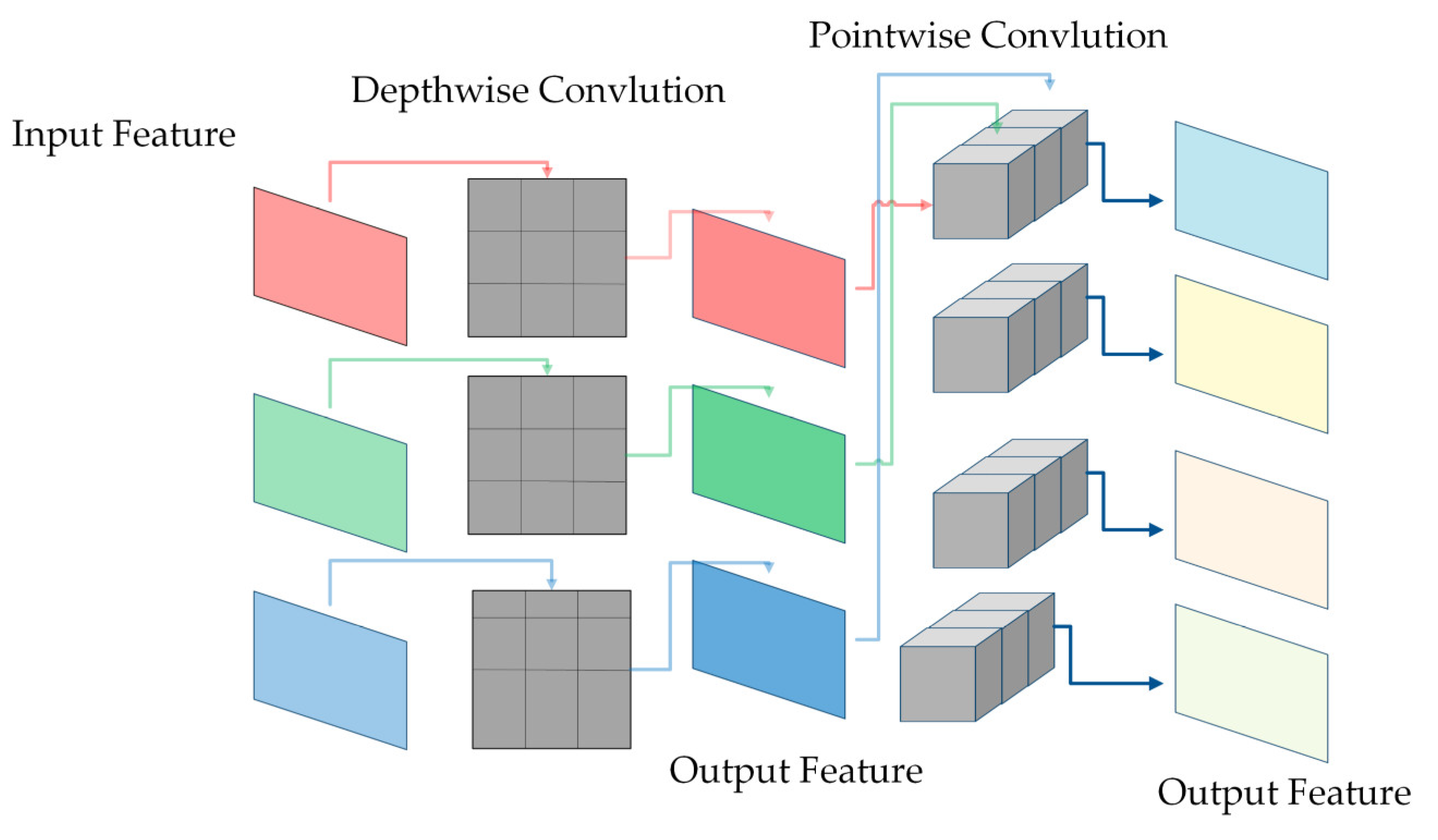


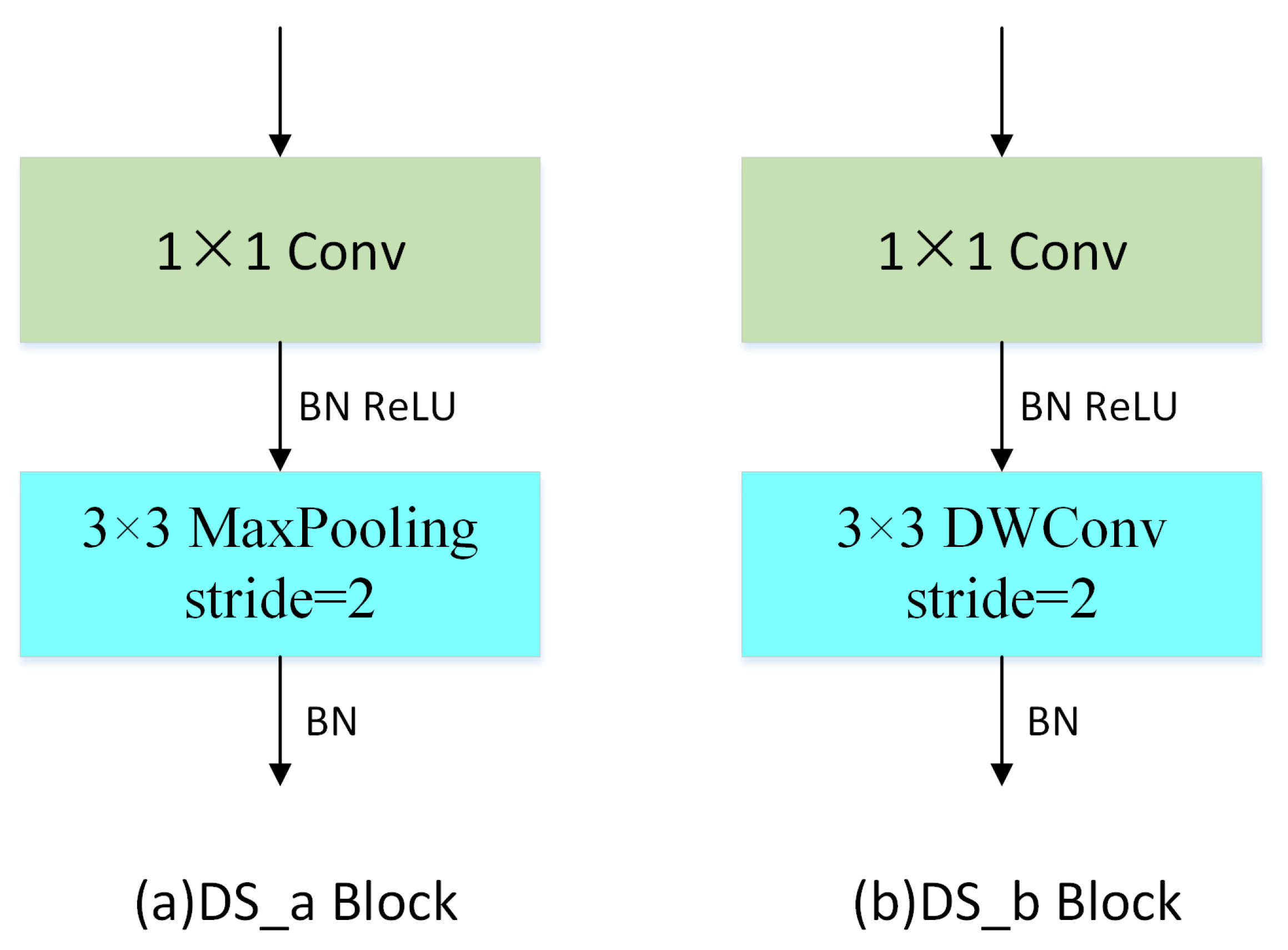
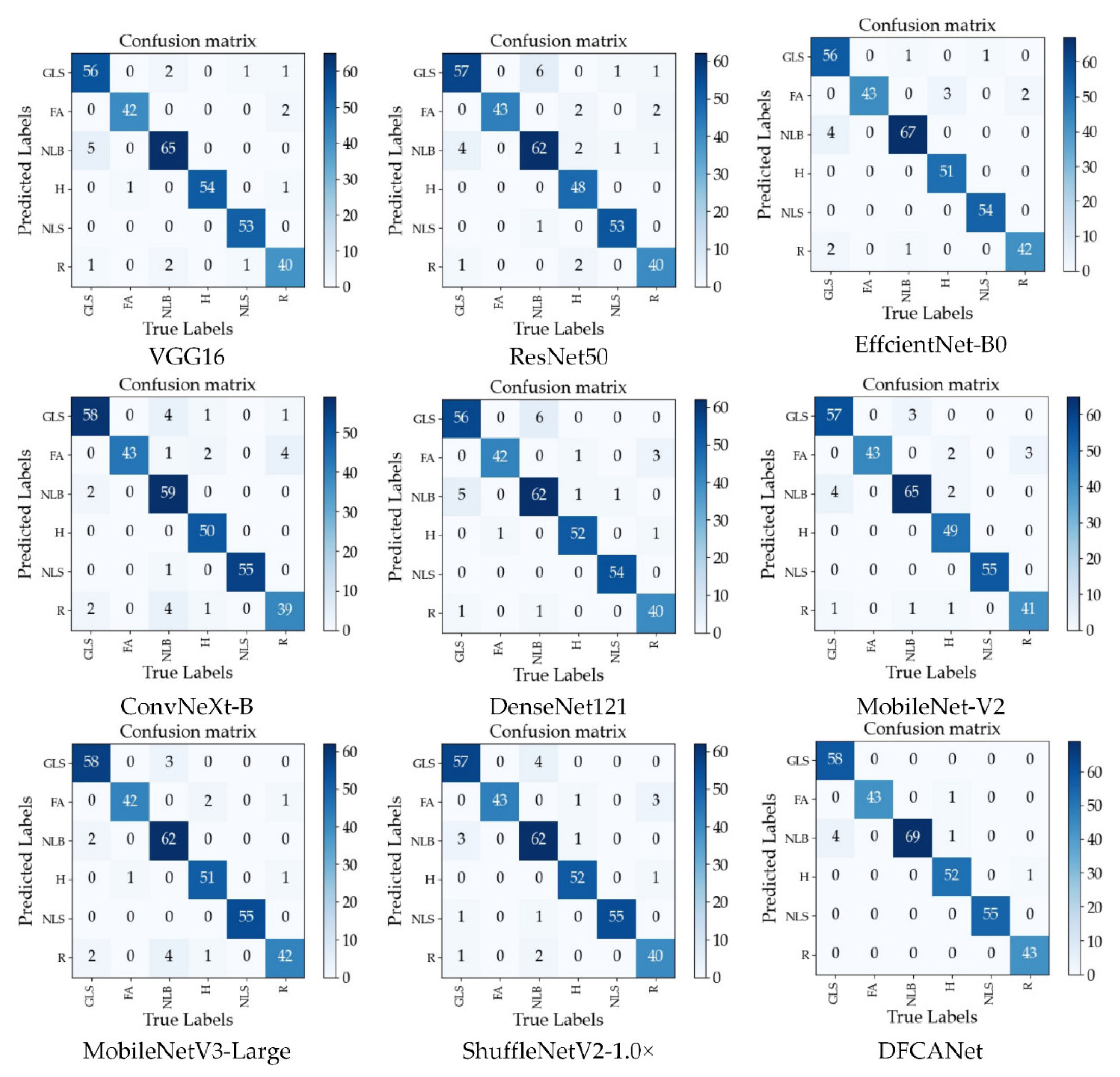
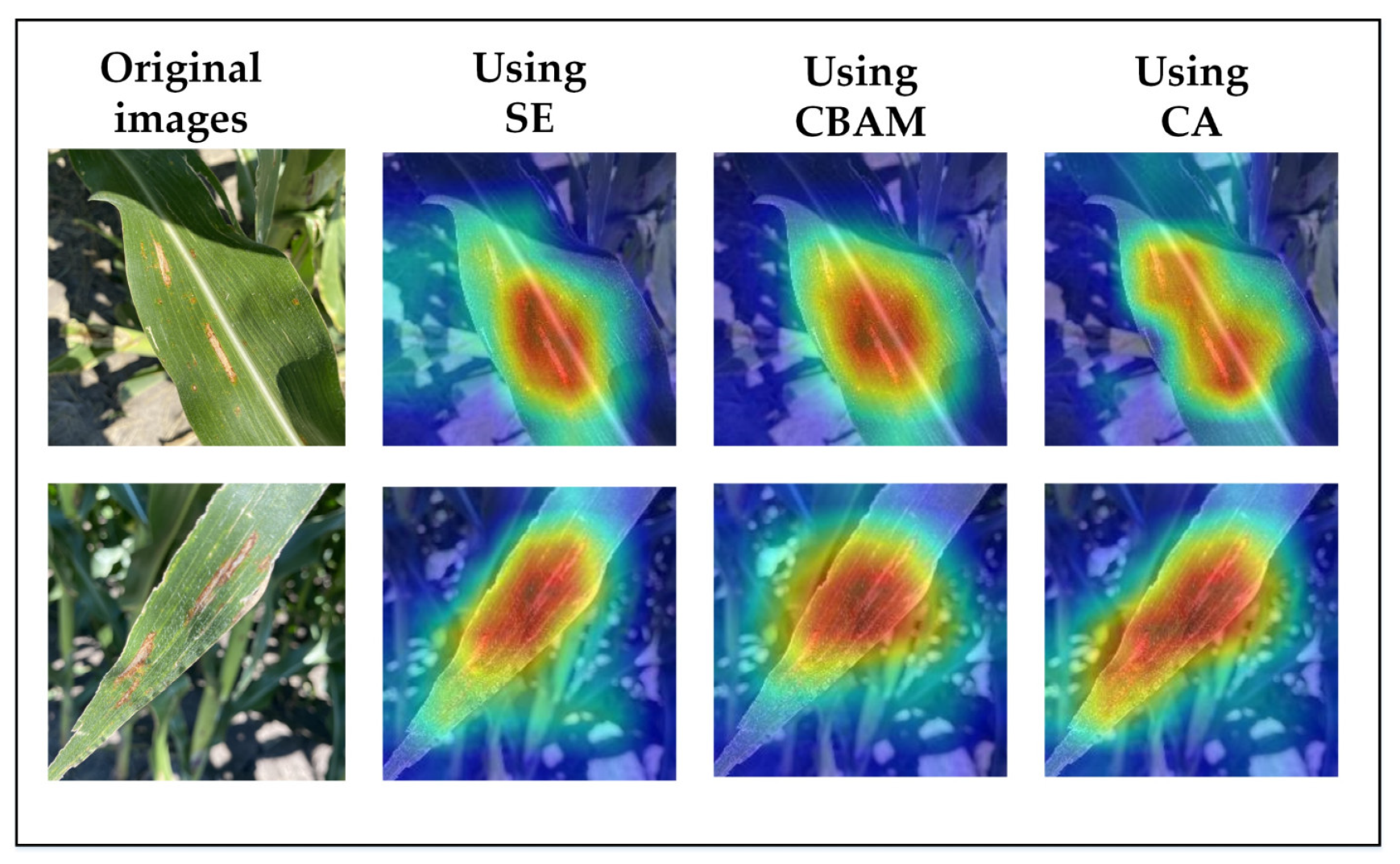

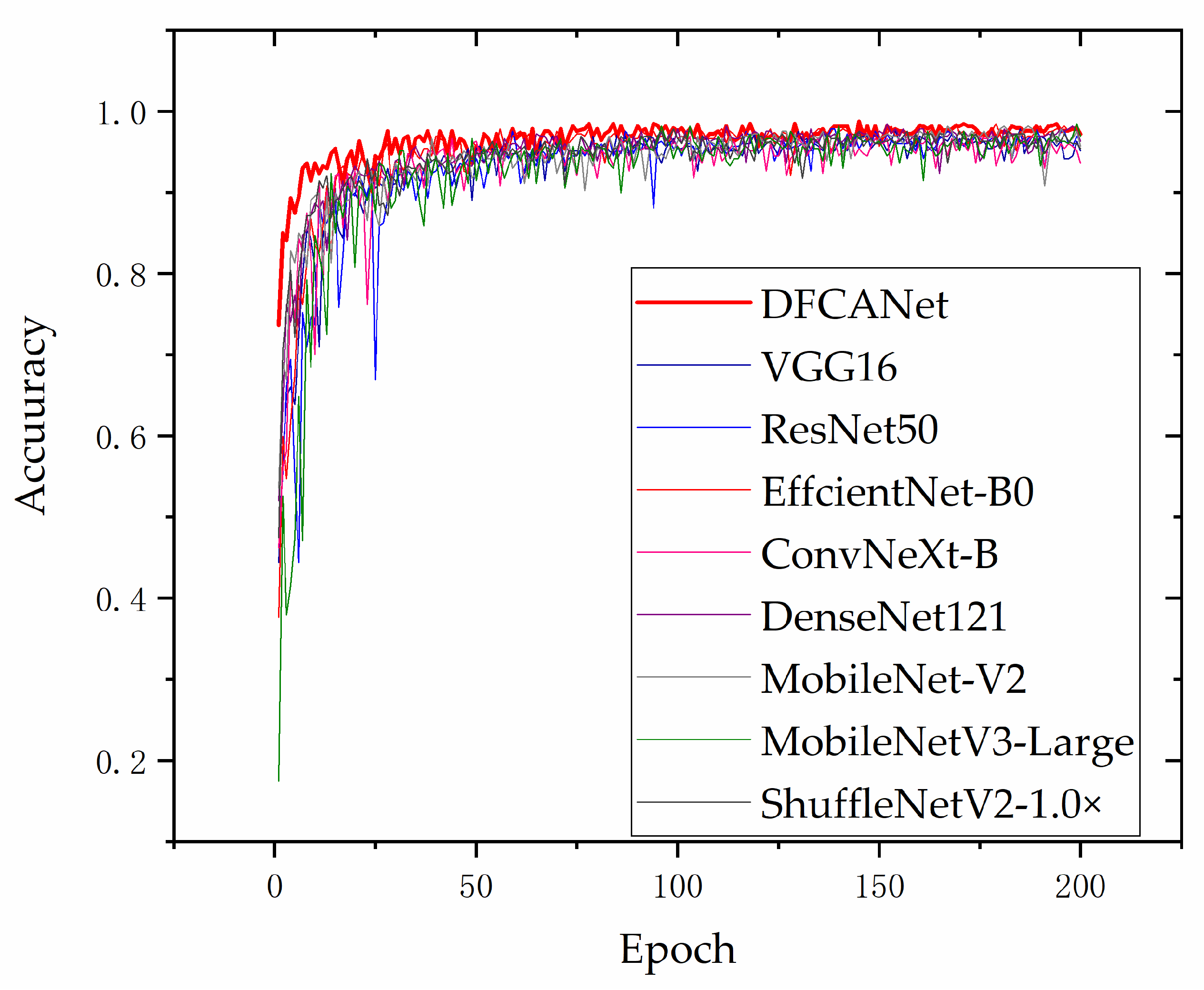
| Method | Dataset | Selected Plant/s | Performance Metrics/Accuracy | Ref |
|---|---|---|---|---|
| SVM | Plantvillage | Corn | 83.7% | [4] |
| SVM | Plantvillage | Corn | 83.7% | [5] |
| Improved LeNet | Plantvillage | Corn | 97.89% | [6] |
| Improved CNN | Plantvillage | Corn | 98.78% | [7] |
| GoogleNet | Plantvillage | 38 classes | 99.35% | [8] |
| CNN | Plantvillage | Corn | 88.46% | [9] |
| DMS-Robust AlexNet | Plantvillage, AI challenge, Google web of site and Self-collected diseases | Corn | 98.62% | [12] |
| SKPSNet-50 | Own practical database | Corn | 92.9% | [13] |
| DADCNN-5 | Own practical database | 44 classes | 97.33% | [14] |
| MobileNet-V2 + Transformer | Kaggle datasets | 3 classes | 96.58% | [15] |
| MS-DNet | Own practical database | Rice | 98.32% | [16] |
| Mobile-Atten | Self-collected diseases | Rice | 98.48% | [17] |
| DISE-NET | Self-collected diseases | Corn | 97.12% | [18] |
| LDSNet | Plantvillage, public website and Self-collected diseases | Corn | 95.4% | [19] |
| GrapeNet | AI challenge | Grape | 86.29% | [20] |
| Input | Operator | Output |
|---|---|---|
| 2242 × 3 | DS | 1122 × 12 |
| 1122 × 12 | DFCA | 1122 × 12 |
| 1122 × 12 | DS | 562 × 48 |
| 562 × 48 | DFCA | 562 × 48 |
| 562 × 48 | DS | 282 × 96 |
| 282 × 96 | DFCA | 282 × 96 |
| 282 × 96 | DS | 142 × 192 |
| 142 × 192 | DFCA | 142 × 192 |
| 142 × 192 | DS | 72 × 384 |
| 72 × 384 | DFCA | 72 × 384 |
| 72 × 384 | Depthwise Conv | 72 × 384 |
| 72 × 384 | AdaptiveAvgPool2d | 12 × 384 |
| 12 × 384 | FC | - |
| Method | Accuracy | Precision | Recall | F1-Score |
|---|---|---|---|---|
| Without augmentation | 0.9541 | 0.9535 | 0.9573 | 0.9547 |
| Cutout | 0.9694 | 0.9720 | 0.9720 | 0.9720 |
| Random Erasing | 0.9633 | 0.9659 | 0.9671 | 0.9665 |
| GridMask | 0.9480 | 0.9504 | 0.9541 | 0.9516 |
| KeepAugment | 0.9785 | 0.9817 | 0.9792 | 0.9803 |
| Model | Accuracy | Precision | Recall | F1-Score | Params (M) | Flops |
|---|---|---|---|---|---|---|
| VGG16 [42] | 0.9480 | 0.9483 | 0.9491 | 0.9485 | 134.29 | 15.50G |
| ResNet50 [39] | 0.9266 | 0.9314 | 0.9299 | 0.9298 | 23.51 | 4.12G |
| EffcientNet-B0 [43] | 0.9571 | 0.9565 | 0.9591 | 0.9568 | 40.09 | 398.02M |
| ConvNeXt-B [38] | 0.9296 | 0.9271 | 0.9336 | 0.9289 | 89.00 | 15.40G |
| DenseNet121 [44] | 0.9357 | 0.9383 | 0.9383 | 0.9383 | 6.96 | 2.88G |
| MobileNet-V2 [40] | 0.9480 | 0.9488 | 0.9500 | 0.9485 | 2.22 | 318.96M |
| MobileNetV3-Large [45] | 0.9480 | 0.9453 | 0.9516 | 0.9476 | 4.20 | 226.43M |
| ShuffleNetV2-1.0× [46] | 0.9449 | 0.9440 | 0.9483 | 0.9460 | 1.26 | 149.57M |
| DFCANet | 0.9785 | 0.9817 | 0.9792 | 0.9803 | 1.91 | 309.1M |
| Attention Mechanism | Accuracy | Precision | Recall | F1-Score | Param (M) | Training Time (Seconds)/Epoch | Test Time (Seconds)/Epoch |
|---|---|---|---|---|---|---|---|
| SE [47] | 0.9633 | 0.9631 | 0.9650 | 0.9638 | 1.89 | 70 | 33 |
| CBAM [48] | 0.9510 | 0.9503 | 0.9561 | 0.9526 | 1.89 | 68 | 33 |
| CA | 0.9785 | 0.9817 | 0.9792 | 0.9803 | 1.91 | 68 | 33 |
| Accuracy | Precision | Recall | F1-Score | Param (M) | Flops | |
|---|---|---|---|---|---|---|
| Baseline | 0.9266 | 0.9263 | 0.9319 | 0.9281 | 1.89 | 302.1M |
| +CA | 0.9388 | 0.9413 | 0.9423 | 0.9413 | 1.91 | 304.6M |
| +Double Fusion | 0.9541 | 0.9605 | 0.956 | 0.9576 | 1.91 | 304.6M |
| +DS Block | 0.9785 | 0.9817 | 0.9792 | 0.9803 | 1.91 | 309.1M |
| Model | Auccary | Precision | Recall | F1-Score | Params (M) | Flops |
|---|---|---|---|---|---|---|
| VGG16 [42] | 0.9663 | 0.9656 | 0.9655 | 0.9643 | 134.29 | 15.50G |
| ResNet50 [39] | 0.9327 | 0.9341 | 0.9359 | 0.9338 | 23.51 | 4.12G |
| EffcientNet-B0 [43] | 0.9724 | 0.9738 | 0.9748 | 0.9736 | 40.09 | 398.02M |
| ConvNeXt-B [38] | 0.9418 | 0.9430 | 0.9460 | 0.9440 | 89.00 | 15.40G |
| DenseNet121 [44] | 0.9571 | 0.9560 | 0.9591 | 0.9568 | 6.96 | 2.88G |
| MobileNet-V2 [40] | 0.9541 | 0.9580 | 0.9576 | 0.9571 | 2.22 | 318.96M |
| MobileNetV3-Large [45] | 0.9633 | 0.9620 | 0.9665 | 0.9638 | 4.20 | 226.43M |
| ShuffleNetV2-1.0× [46] | 0.9480 | 0.9501 | 0.9528 | 0.9508 | 1.26 | 149.57M |
| DFCANet | 0.9847 | 0.9853 | 0.9853 | 0.9853 | 1.91 | 309.1M |
| Method | Plant | Accuracy/% | Ref |
|---|---|---|---|
| SVM | Corn | 83.7% | Aravind et al. [4] |
| SVM | Corn | 83.7% | Budiarianto et al. [5] |
| Improved LeNet | Corn | 97.89% | Ramar et al. [6] |
| Improved CNN | Corn | 98.78% | Panigrahi et al. [7] |
| CNN | Corn | 88.46% | Mishra et al. [9] |
| DFCANet | Corn | 99.74% | - |
| GoogleNet | Plantvillage | 99.35% | Mohanty et al. [8] |
| VGG16 | Plantvillage | 97.82% | Mohameth et al. [50] |
| NasNet | Plantvillage | 99.15% | Huang et al. [51] |
| DFCANet | Plantvillage | 99.58% | - |
| Model | Accuracy | Precision | Recall | F1-Score | Params (M) | Flops |
|---|---|---|---|---|---|---|
| VGG16 [42] | 0.9529 | 0.9632 | 0.9528 | 0.9530 | 134.29 | 15.50G |
| ResNet50 [39] | 0.9745 | 0.9739 | 0.9746 | 0.9743 | 23.51 | 4.12G |
| EffcientNet-B0 [43] | 0.9847 | 0.9850 | 0.9846 | 0.9846 | 40.09 | 398.02M |
| ConvNeXt-B [38] | 0.9477 | 0.9473 | 0.9483 | 0.9476 | 89.00 | 15.40G |
| DenseNet121 [44] | 0.9681 | 0.9680 | 0.9683 | 0.9680 | 6.96 | 2.88G |
| MobileNet-V2 [40] | 0.9757 | 0.9756 | 0.9756 | 0.9756 | 2.22 | 318.96M |
| MobileNetV3-Large [45] | 0.9719 | 0.9730 | 0.9716 | 0.9720 | 4.20 | 226.43M |
| ShuffleNetV2-1.0× [46] | 0.9808 | 0.981 | 0.9813 | 0.981 | 1.26 | 149.57M |
| DFCANet | 0.9923 | 0.9926 | 0.9923 | 0.9923 | 1.91 | 309.1M |
Publisher’s Note: MDPI stays neutral with regard to jurisdictional claims in published maps and institutional affiliations. |
© 2022 by the authors. Licensee MDPI, Basel, Switzerland. This article is an open access article distributed under the terms and conditions of the Creative Commons Attribution (CC BY) license (https://creativecommons.org/licenses/by/4.0/).
Share and Cite
Chen, Y.; Chen, X.; Lin, J.; Pan, R.; Cao, T.; Cai, J.; Yu, D.; Cernava, T.; Zhang, X. DFCANet: A Novel Lightweight Convolutional Neural Network Model for Corn Disease Identification. Agriculture 2022, 12, 2047. https://doi.org/10.3390/agriculture12122047
Chen Y, Chen X, Lin J, Pan R, Cao T, Cai J, Yu D, Cernava T, Zhang X. DFCANet: A Novel Lightweight Convolutional Neural Network Model for Corn Disease Identification. Agriculture. 2022; 12(12):2047. https://doi.org/10.3390/agriculture12122047
Chicago/Turabian StyleChen, Yang, Xiaoyulong Chen, Jianwu Lin, Renyong Pan, Tengbao Cao, Jitong Cai, Dianzhi Yu, Tomislav Cernava, and Xin Zhang. 2022. "DFCANet: A Novel Lightweight Convolutional Neural Network Model for Corn Disease Identification" Agriculture 12, no. 12: 2047. https://doi.org/10.3390/agriculture12122047






